


About Us
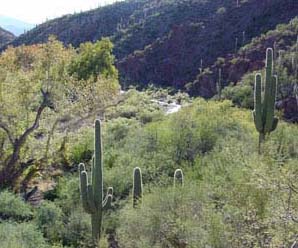 Shareholders:
Shareholders:
The Saguaro-Juniper Corporation began modestly in 1988 when a small group of friends purchased 135 acres in Hot Springs Canyon, a major tributary of the central San Pedro River in southeastern Arizona. After twenty-two years we are surprised to find ourselves a group of some sixty share-holding "associates" holding over 1,000 acres of private deeded land, nearly 8000 acres of state grazing lease, 750 acres of private leases, and to have collaborated with other groups to spawn a separate organization that holds 440 acres and that can also hold conservation easements.
As a group, we Saguaro-Juniper associates would more likely characterize ourselves as stewards or even servants of the land than owners. Many of us come from a background of human rights activism. Having worked with disadvantaged and disenfranchised people, we turned our hearts and attention to the earth (which we could see in a similar light), and are applying to it some of our hard-earned lessons.
The People: 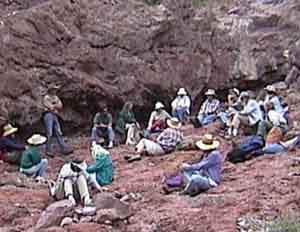 We recognized that as individuals we might perform isolated good deeds, but as a community we could build a viable alternative. Though none of us had much in the way of financial resources, together we could pool those limited resources toward a common end. We also wanted to pool our energy and ideas. Consequently, we operate entirely on a consensual process. There is no voting on actions in our meetings; rather we engage in a lot of discussion, and we all must come to agreement before proceeding. That is not always easy, as we are a diverse and heterogeneous group of various political, religious and environmental persuasions. Still, we have found the organic process of societal interaction to be more lively and fruitful than a corporate style, mission-oriented procedure.
We recognized that as individuals we might perform isolated good deeds, but as a community we could build a viable alternative. Though none of us had much in the way of financial resources, together we could pool those limited resources toward a common end. We also wanted to pool our energy and ideas. Consequently, we operate entirely on a consensual process. There is no voting on actions in our meetings; rather we engage in a lot of discussion, and we all must come to agreement before proceeding. That is not always easy, as we are a diverse and heterogeneous group of various political, religious and environmental persuasions. Still, we have found the organic process of societal interaction to be more lively and fruitful than a corporate style, mission-oriented procedure.
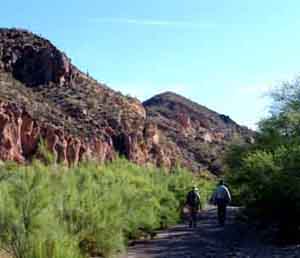 The Land. The S-J community is unique in attempting to embrace all parties including the land, its plants and animals. Located in the heart of what The Nature Conservancy calls one of the world’s “Last Great Places” (see our link: The San Pedro River Drainage), we take that responsibility seriously. Substantial riparian and rangeland improvements are already being experienced. However, we do not take the stance of rigid “protectionists”, in the sense of trying to exclude people from wildlands entirely. Rather,we seek to include human beings as stewards and partners in the natural world, and we may even live on the land if we do so within the Saguaro Juniper Covenant (see this link). In 2009 we completed a series of conservation easements in lower Hot Springs Canyon.
The Land. The S-J community is unique in attempting to embrace all parties including the land, its plants and animals. Located in the heart of what The Nature Conservancy calls one of the world’s “Last Great Places” (see our link: The San Pedro River Drainage), we take that responsibility seriously. Substantial riparian and rangeland improvements are already being experienced. However, we do not take the stance of rigid “protectionists”, in the sense of trying to exclude people from wildlands entirely. Rather,we seek to include human beings as stewards and partners in the natural world, and we may even live on the land if we do so within the Saguaro Juniper Covenant (see this link). In 2009 we completed a series of conservation easements in lower Hot Springs Canyon.
In that spirit, a group within SJC practices cattle ranching. Though some of us merely tolerate this, and others adopt a neutral view of ranching, some embrace it as a way to integrate right-livelihood and conservation. In our ranching, we protect riparian areas, we rotate grazing, we rest the land during the summer growing season, and we treat the animals humanely. (See our link: Grazing and Land Restoration.)
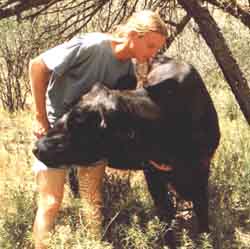 It could be said that, like the Malpai borderlands Group (a coalition of conservation-oriented ranchers), S-J has developed a way which transcends the opposition between “ranchers” and “environmentalists”. Our associates try to be good neighbors to local ranchers and land owners, we participate in and contribute to community groups and activities, and we cooperate with government agencies and conservation organizations alike.
It could be said that, like the Malpai borderlands Group (a coalition of conservation-oriented ranchers), S-J has developed a way which transcends the opposition between “ranchers” and “environmentalists”. Our associates try to be good neighbors to local ranchers and land owners, we participate in and contribute to community groups and activities, and we cooperate with government agencies and conservation organizations alike.
Saguaro-Juniper presents and seeks an alternative to the polarization between humans and nature, between me-first individualism and passive reliance on governmental intervention. It is perhaps an unconventional approach, but one that continues to survive and grow.
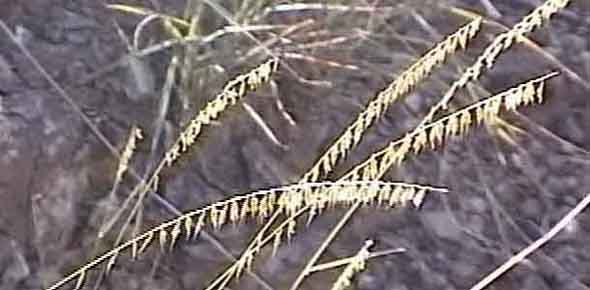
Back to SJ home